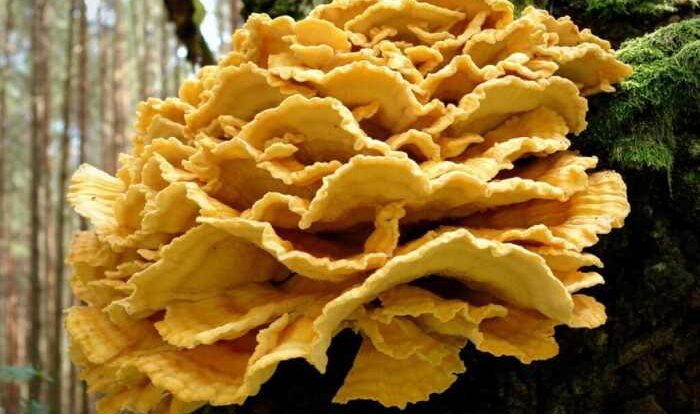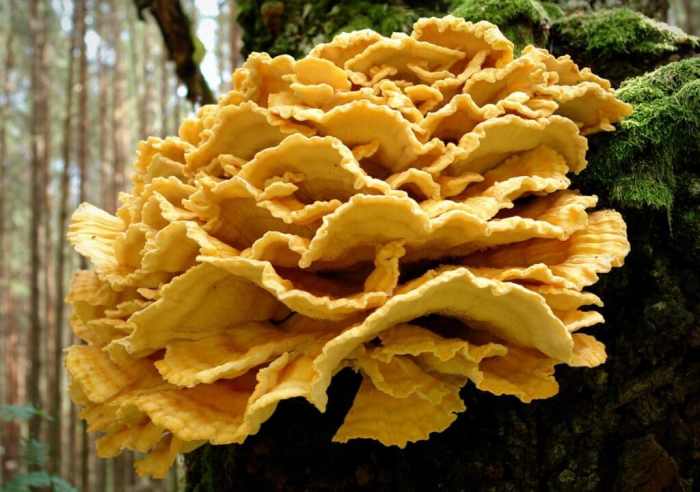
Embark on a culinary adventure with the captivating Chicken of the Woods recipe. This extraordinary mushroom boasts a unique flavor profile that mimics chicken, making it an enticing meat substitute. Dive into a world of tantalizing recipes, nutritional benefits, and foraging techniques that will transform your cooking repertoire.
Chicken of the Woods, a culinary gem, not only delights the palate but also nourishes the body. Discover its nutritional prowess, including its ability to boost immunity and combat inflammation. Learn how to incorporate this versatile mushroom into your diet for optimal health and well-being.
Culinary Delights with Chicken of the Woods: Chicken Of The Woods Recipe
Chicken of the woods (Laetiporus sulphureus) is a unique and flavorful mushroom that has gained popularity among culinary enthusiasts. Its vibrant orange color and meaty texture make it a striking addition to any dish. The flavor profile of chicken of the woods is often described as having a slightly sweet and nutty taste, with a hint of umami.
This versatility makes it an excellent ingredient for a wide range of culinary applications.
Sautéing Chicken of the Woods
Sautéing is a quick and easy method for cooking chicken of the woods. To sauté, heat some olive oil in a pan over medium heat. Once the oil is shimmering, add the sliced mushrooms and cook until they are golden brown and tender, about 5-7 minutes.
If you’re looking for a unique and delicious vegetarian meal, look no further than chicken of the woods . This mushroom has a meaty texture and a slightly earthy flavor, making it a great substitute for chicken in many dishes.
With its versatility and ease of preparation, chicken of the woods is sure to become a favorite in your kitchen.
Season with salt and pepper to taste.
Roasting Chicken of the Woods, Chicken of the woods recipe
Roasting chicken of the woods is a great way to bring out its natural sweetness. Preheat your oven to 400°F (200°C). Toss the mushrooms with some olive oil, salt, and pepper. Spread them on a baking sheet and roast for 20-25 minutes, or until they are tender and slightly caramelized.
Grilling Chicken of the Woods
Grilling chicken of the woods is a smoky and flavorful option. Preheat your grill to medium-high heat. Brush the mushrooms with some olive oil and season with salt and pepper. Grill for 5-7 minutes per side, or until they are tender and slightly charred.
Tips for Enhancing the Flavor and Texture
Here are a few tips for enhancing the flavor and texture of chicken of the woods:
- Use fresh mushrooms for the best flavor and texture.
- Slice the mushrooms into thin strips for sautéing or grilling.
- Season the mushrooms generously with salt and pepper.
- Add some herbs or spices to the mushrooms for extra flavor, such as thyme, rosemary, or paprika.
- Cook the mushrooms until they are tender but still have a slight bite to them.
Nutritional Benefits of Chicken of the Woods

Chicken of the woods, with its bright orange color and delectable flavor, boasts an impressive nutritional profile. This edible mushroom is a treasure trove of vitamins, minerals, and antioxidants, offering a myriad of potential health benefits.
Chicken of the woods is particularly rich in vitamin D, essential for bone health and immune system function. It also contains an abundance of vitamin C, a potent antioxidant that helps protect cells from damage. Additionally, this mushroom is a good source of fiber, which supports digestive health and promotes satiety.
Boosting Immunity
Chicken of the woods contains compounds that have been shown to enhance immune function. Beta-glucans, a type of polysaccharide found in the mushroom, have been linked to increased production of immune cells, such as macrophages and natural killer cells. These cells play a crucial role in defending the body against infections and diseases.
Reducing Inflammation
Chicken of the woods possesses anti-inflammatory properties that may help alleviate inflammation throughout the body. Its ergothioneine content, a unique antioxidant, has been found to reduce inflammation in various tissues, including the brain, liver, and heart. This anti-inflammatory effect may contribute to the mushroom’s potential benefits in conditions such as arthritis and inflammatory bowel disease.
Incorporating into a Balanced Diet
To reap the nutritional benefits of chicken of the woods, incorporate it into your diet in moderation. It can be cooked in various ways, such as sautéing, roasting, or grilling. When adding chicken of the woods to your meals, consider its strong flavor and adjust seasonings accordingly.
It pairs well with dishes that have bold flavors, such as stews, soups, and stir-fries.
Foraging for Chicken of the Woods

Chicken of the woods is a prized edible mushroom that can be found in forests throughout the world. It is known for its bright orange color and its meaty, flavorful texture.
If you’re looking for a vegetarian or vegan alternative to chicken, the chicken of the woods recipe is a perfect choice. This mushroom has a similar texture and flavor to chicken, making it a great option for those who want to reduce their meat consumption.
With its versatility and ease of preparation, the chicken of the woods recipe is a great way to add some variety to your plant-based diet.
To find chicken of the woods, look for it growing on dead or dying hardwood trees, especially oaks. It is most commonly found in the fall, but it can also be found in the spring and summer.
If you’re looking for a delicious and unique dish, try the chicken of the woods recipe . This mushroom is known for its meaty texture and flavorful taste, making it a great substitute for chicken in many dishes. With just a few simple ingredients and easy-to-follow instructions, you can create a mouthwatering meal that will impress your family and friends.
Identifying Chicken of the Woods
Chicken of the woods is a large mushroom, with a cap that can grow up to 12 inches wide. The cap is typically bright orange, but it can also be yellow or pink. The gills on the underside of the cap are white or cream-colored.
The stem is short and thick, and it is often attached to the side of the cap.
Chicken of the woods can be distinguished from other similar species by its bright orange color and its meaty texture. However, it is important to be sure that you have correctly identified the mushroom before eating it, as some similar species can be poisonous.
Ethical and Sustainable Foraging Practices
When foraging for chicken of the woods, it is important to follow ethical and sustainable practices. These practices include:
- Only taking what you need.
- Leaving the mushroom intact so that it can continue to grow.
- Avoiding areas that have been treated with pesticides or herbicides.
- Being aware of your surroundings and respecting the environment.
Culinary Comparisons with Chicken

Chicken of the woods has a unique taste and texture that set it apart from traditional chicken. Its flavor is often described as nutty, earthy, and slightly sweet, with a chewy texture that resembles chicken meat. This makes it a versatile ingredient that can be used in a variety of dishes.One
of the most popular ways to cook chicken of the woods is to sauté it with butter or oil. This method brings out its nutty flavor and creates a crispy exterior. It can also be grilled, roasted, or fried, depending on your preference.Chicken
of the woods is a great meat substitute in various dishes. It can be used in soups, stews, curries, and stir-fries. Its chewy texture and mild flavor make it a suitable replacement for chicken in many recipes.In addition to its culinary versatility, chicken of the woods offers several environmental and health benefits.
It is a low-calorie, high-fiber food that is also a good source of protein, vitamins, and minerals. It is also sustainably harvested, making it a more environmentally friendly choice than traditional chicken.
Using Chicken of the Woods in Various Dishes
Chicken of the woods can be used in a variety of dishes, including:
- Soups and stews
- Curries
- Stir-fries
- Tacos
- Burgers
- Pizza
It can be cooked in a variety of ways, including:
- Sautéing
- Grilling
- Roasting
- Frying
Creative Recipes with Chicken of the Woods

The versatility of chicken of the woods extends beyond its ability to mimic chicken meat. It lends itself to a wide range of culinary creations, from savory appetizers to delectable desserts. Its unique texture and earthy flavor make it an exciting ingredient to experiment with.
In this section, we will delve into innovative recipes that showcase the versatility of chicken of the woods. We will explore different cuisines and flavor combinations that complement the mushroom, providing ideas for incorporating it into appetizers, entrees, and even desserts.
Appetizers
- Chicken of the Woods Bruschetta: Marinated chicken of the woods is sautéed and served on toasted bread slices topped with a creamy goat cheese spread and a drizzle of balsamic glaze.
- Chicken of the Woods Fritters: Bite-sized fritters made with a batter of chicken of the woods, flour, and spices. Serve with a tangy dipping sauce.
- Chicken of the Woods Crostini: Thinly sliced chicken of the woods is roasted with herbs and garlic, then served on toasted crostini with a dollop of whipped ricotta.
Last Recap

Our journey through the Chicken of the Woods recipe concludes with a symphony of flavors and insights. This remarkable mushroom offers a culinary canvas for creativity, inspiring innovative recipes that showcase its versatility. Whether you’re a seasoned chef or a culinary novice, embrace the culinary delights and health benefits of Chicken of the Woods.
Let its earthy essence enhance your meals and nourish your body.
Expert Answers
What is the ideal habitat for Chicken of the Woods?
Chicken of the Woods thrives in moist, shady forests, often found at the base of oak or maple trees.
How can I distinguish Chicken of the Woods from similar species?
Look for its distinctive orange-yellow color, ruffled edges, and white pores on the underside.
What are some creative ways to use Chicken of the Woods in cooking?
Experiment with sautéing, roasting, grilling, or incorporating it into soups, stews, and even desserts.





